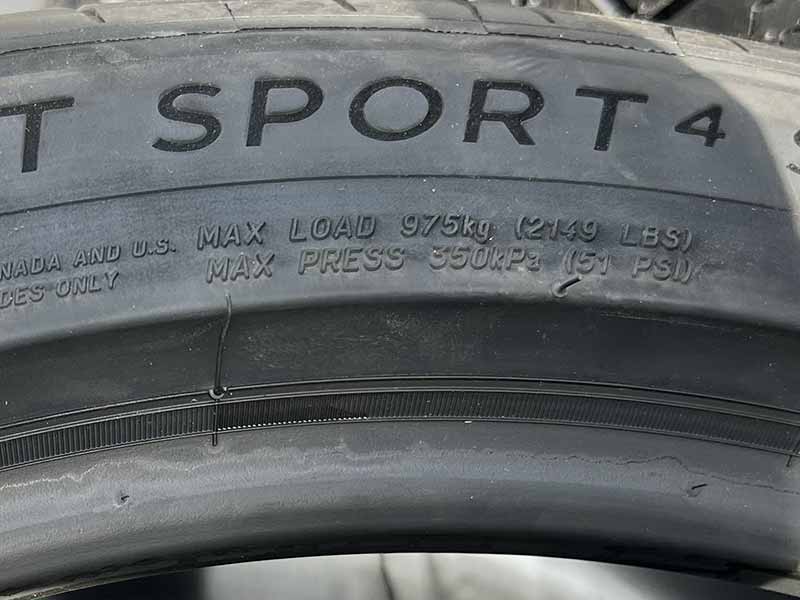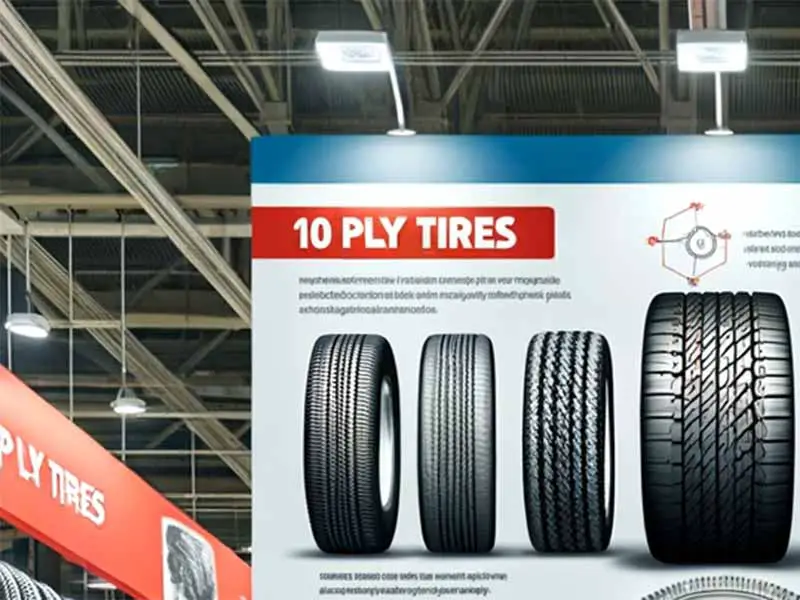Ever wondered what “10 Ply Tires” really means? Dive deep into the world of tires, where layers tell a story of strength, durability, and the journey ahead.
10 Ply Tires Meaning (Load Range)?
A 10 ply tire has a load range of E (either E1 or E2), which means the tire can handle up to 1,520 lbs at the proper air pressure. Load range E1 is 80 psi and load range E2 is 65 psi.
In this article, we’ll explain ply ratings, the connection between load range and ply rating, decode the markings on a tire’s sidewall, and delve into the specific needs of different vehicle types, ensuring you’re equipped with the knowledge to make informed tire choices.
Load Range and Ply Rating Chart
| Load Range | Ply Rating | Max Load Carrying Air Pressure |
| Standard Load (SL) | 4 | @ 36 PSI |
| Extra Load (XL) | 4 | @ 42 PSI |
| C1 | 6 | @ 50 PSI |
| C2 | 6 | @ 35 PSI |
| D1 | 8 | @ 65 PSI |
| D2 | 8 | @ 50 PSI |
| E1 | 10 | @ 80 PSI |
| E2 | 10 | @ 65 PSI |
| F1 | 12 | @ 95 PSI |
| G | 14 | @ 110 PSI |
What Does Load Range E Mean?
The load-carrying capacity of light trucks is primarily categorized by their load range. The specific load range letter of a tire, such as “E”, determines the maximum load pressure a single tire can handle. The load range letter also dictates the maximum allowable PSI levels of the specific tire.
Load Range E: A Deep Dive
Load Range E tires come with a 10-ply rating. This means that the tire’s construction offers strength equivalent to a 10-ply structure, even if it doesn’t necessarily consist of 10 physical plies. In practical terms, a Load Range E rating signifies that a single tire can handle a weight of 1,520 lbs at an air pressure of 80 PSI.
All tires with this rating will have the same maximum load carrying capacity, thanks to their cord layers, plies, and internal structure. They can carry more weight than Load Range D or C tires but less than Load Range H tires.
E1 vs. E2 Load Range: A Closer Look
While Load Range E is a common term, there are further classifications within it, namely E1 and E2. Both these ratings offer similar maximum load and performance, but the difference lies in their sizes.
- E1 Tire Rating: These tires have a footprint width lower than 305mm and require 80 PSI to perform optimally. They are perfect for on-road use, optimizing road grip. Whether it’s a trailer tire or one used for towing, Load Range E1 ensures excellent driving safety.
- E2 Tire Rating: These tires come with footprints that are 305mm wide or even wider. They operate at a lower PSI (around 65 PSI), enhancing their flotation, crucial for off-road use. E2-rated tires use LT-flotation to grip surfaces and optimize off-road traction. Despite the lower PSI, Load Range E2 tires offer the same maximum load-carrying capacity as E1.

What is Ply Rating?
Historically, it referred to the number of layers of cotton fabric used in the tire’s construction. But as with many things, technology and innovation have reshaped its meaning.
Understanding the Basics
Ply rating and load range are terms that often go hand in hand. At its core, the ply rating gives us an insight into a tire’s strength and durability. But here’s a twist: modern tires might have a “10-ply rating” but not actually consist of 10 physical layers. Confused? Let’s delve deeper.
Historical Context: From Cotton to Modern Materials
Back in the day, tires were reinforced using layers made from cotton fabric. The more layers or plies a tire had, the stronger and more durable it was perceived to be. However, with the introduction of stronger materials like nylon, the actual number of layers needed decreased, but the strength and durability increased. This evolution led to a shift in how we understand ply ratings today.
For instance, a modern tire with a ply rating of “10” might only have 2 or 3 actual layers, but its strength and durability would be equivalent to the old 10-layer cotton tire. This transition in materials and technology ensures that our tires are more efficient, durable, and safer than ever before.

The Connection Between Load Range and Ply Rating
When diving into the intricacies of tires, it’s essential to understand the relationship between load range and ply rating. While they might seem like two separate entities, they are closely intertwined, each providing valuable insights into a tire’s capabilities.
Load Range: More Than Just Weight
At its essence, the load range indicates the maximum weight a tire can safely support. It’s a direct reflection of the tire’s strength and durability. But it’s not just about weight; the load range also gives insights into how a tire will perform under various conditions, from carrying heavy cargo to cruising on a highway.
Ply Rating: A Legacy Metric
As we’ve learned, the ply rating no longer refers to the actual number of layers in a tire. Instead, it’s a legacy term that provides a comparative measure of a tire’s strength. Think of it as a bridge between the past and the present, connecting historical tire construction methods with modern innovations.
For instance, a tire with a ply rating of “8” might be equivalent in strength to an old 8-layer cotton tire, even if it only has a few actual layers made of advanced materials.
How They Work Together
The beauty lies in their collaboration. While the ply rating gives us a historical context, the load range provides a real-world application. By understanding both, vehicle owners can ensure they’re equipping their vehicles with tires that offer optimal performance, safety, and longevity.
Remember: When choosing tires, it’s not just about size or tread pattern. The load range and ply rating play pivotal roles in ensuring your vehicle is road-ready and safe.

Identifying Load Range and Ply Rating
Among the various markings on the sidewall, the load range and ply rating hold significant importance. Typically represented by letters (e.g., “E” for Load Range E), these markings indicate the tire’s strength and its ability to carry weight.
Other Key Markings to Note
- Load Index: This number indicates the maximum weight the tire can support when fully inflated. It’s crucial to ensure that the load index aligns with your vehicle’s requirements.
- Maximum Load Pressure: This marking indicates the maximum air pressure the tire can safely handle. It’s essential to maintain proper tire pressure for optimal performance and safety.
- Tire Construction: Whether it’s radial or bias-ply, the tire’s construction type impacts its performance, durability, and ride comfort.
Passenger and Light Truck Tires
Let’s briefly cover the differences between passenger tires and light truck tires.
Passenger Tires: From Light Load to Extra Load
Passenger tires are primarily designed for cars, SUVs, and smaller trucks. They focus on providing comfort, fuel efficiency, and road performance. Within this category, there are distinct sub-classifications based on load capacity:
- Light Load (LL) Tires: Tailored for vehicles that don’t often carry heavy loads. They are optimized for fuel efficiency and a smooth ride, making them perfect for daily commuting and city driving.
- Key Features:
- Lower maximum load capacity
- Prioritizes comfort and efficiency
- Key Features:
- Standard Load (SL) Tires: The most versatile type, suitable for a broad range of passenger vehicles. They strike a balance between performance and durability.
- Key Features:
- Moderate load capacity
- Fits most passenger vehicles
- Key Features:
- Extra Load (XL) Tires: For those who demand more from their tires. Whether it’s frequent highway journeys, carrying extra passengers, or light towing, these tires are up to the challenge.
- Key Features:
- Enhanced durability and load capacity
- Ideal for vehicles that often carry heavier loads
- Key Features:
Light Truck (LT) Tires: Meeting the Demands of Heavier Vehicles
Unlike passenger tires, LT tires are crafted with trucks, SUVs, and larger vehicles in mind. They prioritize durability, load capacity, and off-road performance.
- Defining Features of LT Tires:
- Reinforced construction for added resilience
- Higher load capacities to accommodate heavier weights
- Tread patterns suitable for diverse terrains
Within the LT tire category, load ranges are typically represented by letters, such as C, D, or E. Each letter corresponds to a specific ply rating and load carrying capacity:
- Load Range C: Ideal for lighter trucks and vans. These tires can handle moderate loads, making them suitable for city driving and light-duty tasks.
- Load Range D: A step up in durability and strength. Perfect for medium-duty trucks that often carry cargo or tow trailers.
- Load Range E: The titans of the LT tire world. Crafted for the most demanding tasks, these tires can handle substantial weights, making them a top choice for heavy-duty trucks and commercial vehicles.

Who Needs 10 Ply Tires?
Let’s delve into the scenarios and types of drivers that would most benefit from 10 ply tires:
Heavy-Duty Truck Owners
For those who own heavy-duty trucks, whether for work or recreation, 10 ply tires are almost a necessity. These trucks are designed to carry heavy loads, tow trailers, or even haul equipment. The strength and durability of 10 ply tires ensure that the vehicle can handle the weight without compromising on safety or performance.
Recreational Vehicle (RV) Enthusiasts
RVs and campers are hefty, especially when fully loaded with amenities, supplies, and sometimes even a vehicle being towed behind. 10 ply tires provide the necessary support and stability, ensuring smooth and safe travels, whether you’re on a weekend getaway or a cross-country road trip.
Off-Road Adventurers
For those who love to venture off the beaten path, the ruggedness of 10 ply tires is a boon. These tires are designed to handle rough terrains, from rocky landscapes to muddy trails. Their reinforced construction ensures they won’t easily get punctured or damaged, allowing for worry-free adventures.
Commercial Vehicle Operators
Drivers of commercial vehicles, such as delivery trucks or vans, often carry heavy cargo. The weight can vary daily, from light parcels to heavy equipment. 10 ply tires offer the flexibility and strength to handle these varying loads, ensuring timely and safe deliveries.
Towing Enthusiasts
Whether it’s a boat, trailer, or another vehicle, towing requires tires that can handle the added weight. 10 ply tires, with their high load capacity, are ideal for such tasks. They ensure that both the towing vehicle and the towed item remain stable and secure on the road.
Drivers in Harsh Climates
In areas prone to severe weather conditions, such as heavy snowfall or torrential rains, 10 ply tires can offer better traction and stability. Their robust construction can withstand the challenges posed by such environments, ensuring a safer driving experience.
Resources
Below are some links you may find helpful when learning about tires:
- 10 Ply All-Terrain Tires – Discount Tire
- How to understand tire ply ratings and what they mean. – Les Schwab
Final Thoughts
Understanding the significance of ply ratings, especially the 10 ply tires, is crucial for vehicle owners, especially those who frequently engage in heavy-duty tasks, off-road adventures, or towing activities. These tires, with their reinforced construction and enhanced load-carrying capacity, offer a blend of durability, performance, and safety.
Whether you’re an everyday commuter, an off-road enthusiast, or someone who requires tires for commercial purposes, being informed about the intricacies of ply ratings and load ranges will empower you to make the right tire choices for your vehicle.
Good luck and happy motoring.




